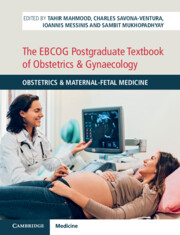Book contents
- The EBCOG Postgraduate Textbook of Obstetrics & Gynaecology
- The EBCOG Postgraduate Textbook of Obstetrics & Gynaecology
- Copyright page
- Dedication
- Contents
- Contributors
- Preface
- Section 1 Basic Sciences in Obstetrics
- Chapter 1 Surgical Anatomy of the Female Pelvis
- Chapter 2 Maternal Physiology during Pregnancy, Including Immunology of Pregnancy
- Chapter 3 Developmental Abnormalities of the Reproductive System and Their Relevance to Obstetric Practice
- Chapter 4 Pharmacology and Pharmacokinetics in Obstetric Practice
- Chapter 5 Genetics in Fetomaternal Medicine
- Section 2 Early Pregnancy Problems
- Section 3 Fetal Medicine
- Section 4 Maternal Medicine
- Section 5 Intrapartum Care
- Section 6 Neonatal Problems
- Section 7 Placenta
- Section 8 Public Health Issues in Obstetrics
- Section 9 Co-Morbidities during Pregnancy
- Index
- Plate Section (PDF Only)
- References
Chapter 1 - Surgical Anatomy of the Female Pelvis
from Section 1 - Basic Sciences in Obstetrics
Published online by Cambridge University Press: 20 November 2021
- The EBCOG Postgraduate Textbook of Obstetrics & Gynaecology
- The EBCOG Postgraduate Textbook of Obstetrics & Gynaecology
- Copyright page
- Dedication
- Contents
- Contributors
- Preface
- Section 1 Basic Sciences in Obstetrics
- Chapter 1 Surgical Anatomy of the Female Pelvis
- Chapter 2 Maternal Physiology during Pregnancy, Including Immunology of Pregnancy
- Chapter 3 Developmental Abnormalities of the Reproductive System and Their Relevance to Obstetric Practice
- Chapter 4 Pharmacology and Pharmacokinetics in Obstetric Practice
- Chapter 5 Genetics in Fetomaternal Medicine
- Section 2 Early Pregnancy Problems
- Section 3 Fetal Medicine
- Section 4 Maternal Medicine
- Section 5 Intrapartum Care
- Section 6 Neonatal Problems
- Section 7 Placenta
- Section 8 Public Health Issues in Obstetrics
- Section 9 Co-Morbidities during Pregnancy
- Index
- Plate Section (PDF Only)
- References
Summary
The female genitourinary system is mainly derived from the intermediate cell mass, which in turn is derived from the mesoderm following gastrulation. The pelvic girdle, however, is derived from the caudal mesoderm, which, as the name implies, is the mesoderm found caudal to the cloacal membrane. Upon folding, the caudal mesoderm folds ventrally at the point of the cloacal membrane, distal to the paraxial mesoderm and notochord, in such a way that the pelvic girdle wraps around the distal end of the trunk to fuse with the sacral somites and encase the developing female genitourinary system, and leads to the formation of the rump. Blastogenic defects involving the cloaca and caudal folding may also be associated with urogenital and possibly ano-rectal malformations, which can lead to reproductive problems [1].
- Type
- Chapter
- Information
- The EBCOG Postgraduate Textbook of Obstetrics & GynaecologyObstetrics & Maternal-Fetal Medicine, pp. 1 - 7Publisher: Cambridge University PressPrint publication year: 2021

